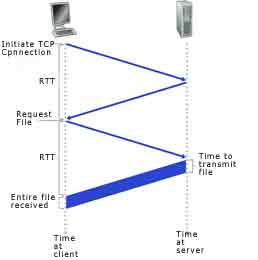 |
 |
 |
 |
 |
 |
||||
|
| The browser receives the Web page; it displays the page to the user. HTTP has nothing to do with how a Web page is interpreted by a client, the specification of the HTTP define only the communication protocol between the client HTTP program and the server HTTP program. Consider what happens when a user click s a hyperlink. This causes the browser to imitate a TCP connection between the browser and the Web server; this involves a three- way “handshake”—the client sends a small TCP segment to the server, the server acknowledges and responds with a small TCP segment, and, finally, the client acknowledges back to the server. The first two parts of the three-way handshake takes one round-trip time (RTT) . After the first two parts are completed, the client sends the HTTP request message combined with the third part of the three way handshake into the TCP connection. Once the request message arrives at the server, the server sends the HTML file into the TCP connection. This HTTP takes up another RTT, thus, roughly, the total response time is two RTTs plus the transmission time of the server of the HTML file. |
 |
With persistent connections , the server leaves the TCP connection open after sending a response. Subsequent requests and responses between the same client and server can be sent over the same connections. An entire Web page or multiple Web pages residing on the same server can be sent from the server to the same client over a single persistent TCP connection. There are two versions of persistent connections: without pipelining and with pipelining. Without pipelining, the client issues a new request only when the previous response has been received. The client experiences one RTT in order to request and receive each of the referenced objects. |
RTT delay can be further reduced with pipelining. Another disadvantage of no pipelining is |